Permaculture Plants
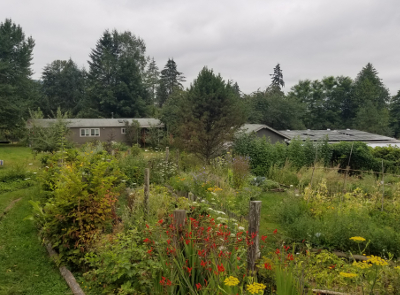
By Ben Mardis
In this article I will highlight fifteen helpful permaculture plants that will serve you well whether you are planning to start a garden, landscaping around your property, or going all out on a sustainable homestead design!
Peruse garden magazines or the local book store and you’ll quickly see that there is no shortage of great resources available to you in the quest to find great permaculture plants. With these many resources comes a wide range of different terminology, opinions, strategies, and plant compendiums of all kinds. My aim is to simplify this down to fifteen great choices.
Strategically choosing the right permaculture plants, for the right location, and for the right purposes will set you up for short and long-term success. Choosing permaculture plants is fun and with so many varieties available, one is limited only by their imagination.
The concept of a “food forest” is great way to think about which permaculture plants to use and where to put them to create a symbiotic system that, in time, will require very minimal maintenance and will produce food for humans, insects, and wildlife. Take a look at the conceptual drawing below before you go through the listed permaculture plants, and think about how each would fit into a similar system.
Welcome to the vast world of permaculture design!
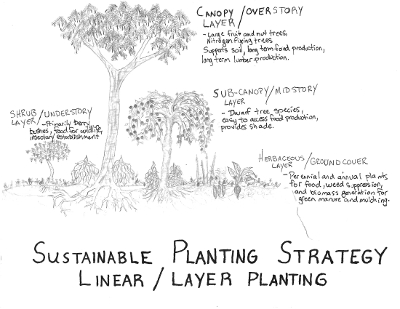 Food forest layers
Food forest layersComfrey (Symphytum spp.)
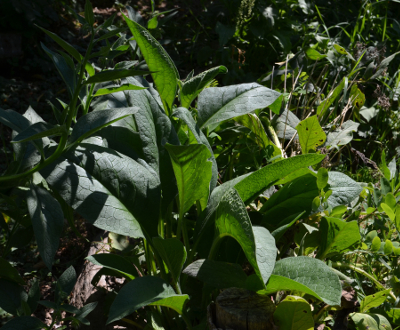 Comfrey plant
Comfrey plant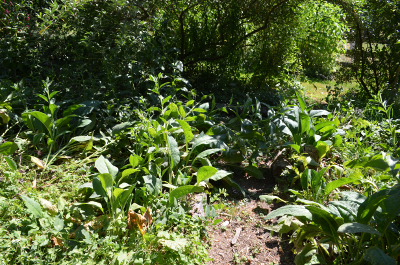 Comfrey bordering a path in the food forest
Comfrey bordering a path in the food forestIf you visit a permaculture site, whether it’s on a large acreage or a backyard, you’ll most likely find comfrey there, and for good reason. Comfrey is fast growing, extremely resilient, and puts out large leaves that can be used to supplement your animal feed or mulch around gardening areas.
I use comfrey leaves to mulch around my potato and onion plot and am in the process of planting comfrey around the base of all my fruit trees to suppress weeds and add to the overall organic matter that is present in the area.
I also use comfrey leaves and roots as medicine to make healing salves.
Comfrey can grow from a tiny piece of root so choose carefully the places you plant because any root scattered from trying to dig it up will just spread!
Mulberry (Morus spp.)
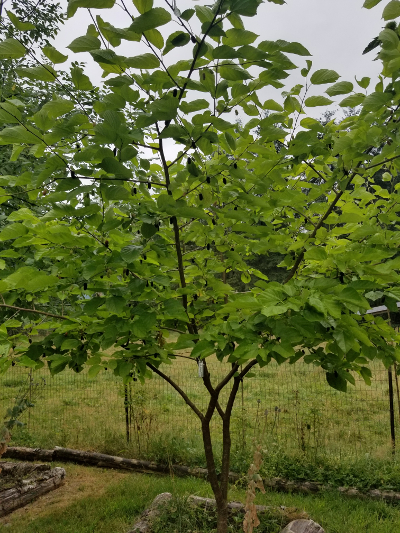 Mulberry sapling
Mulberry sapling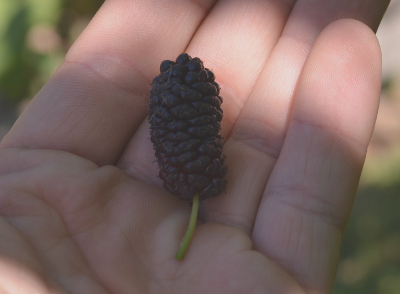 Mulberry berry
Mulberry berryMulberry is known for producing large, delicious berries that are similar to blackberries and for being one of the only trees that can be used to raise silkworms (they eat the leaves). I think it would be neat to raise silkworms but I’m only interested in the fruits for jam and using the leaves for animal fodder.
In the picture above we have black mulberry aka everbearing mulberry (Morus nigra) which grows to the size of a large shrub to a small tree and is known for the sweetness of the berries. I like to describe the taste as follows: “as sweet as a blackberry without the tartness”.
White mulberry (Morus alba) is the specific species widely used for silkworm cultivation and is known to grow into a fairly large tree and produce lackluster berries when compared with other mulberry varieties.
You can see in this example that one species in a particular genus can have much different characteristics than another.
Jerusalem Sage (Phlomis fruticose)
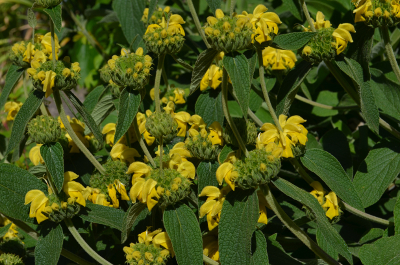 Jerusalem sage
Jerusalem sageI encountered this interesting specimen during a trip to Portland, Oregon and it stuck with me as a plant I definitely want to grow someday.
The Jerusalem sage in the picture was grown as a part of a privacy screen for a residence. It is aesthetically pleasing with fuzzy, sage-like leaves and vibrant yellow flowers.
Ready for the kicker? Tug on one of the flowers and it will pop out of its “socket”. You can then suck the nectar out just like you would a honeysuckle flower. There is considerably more nectar in these than in honeysuckles and they are a nice treat for the passerby who recognizes them.
Rose (Rosa spp.)
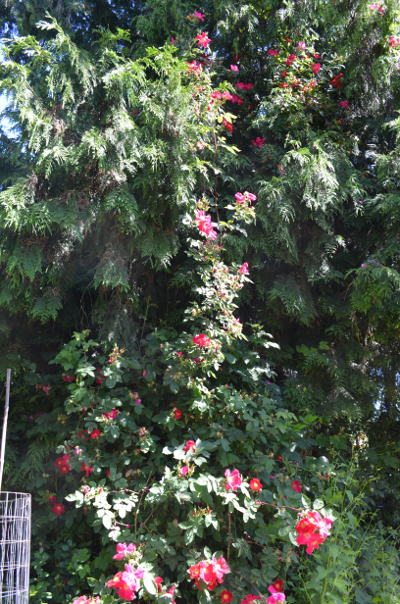 Rose bush climbing a cedar tree
Rose bush climbing a cedar treeThe rose in the picture has climbed its way up a western red cedar tree and adds a bit of wild scenery to the border of this backyard garden and attracts pollinators.
There are many varieties of rose to choose from and unless you want to propagate a native rose species, which would be great, you will most likely be choosing from a long list of hybrids.
Different roses have been cultivated for specialized growing patterns, flower colorations, sizes and scents.
When I come upon a rose bush, my first question is “are the rose hips tasty?” The attractive inflorescence is secondary to me when compared with the potential for great tasting rose hips.
Rose hips are high in vitamin C and are used medicinally for a number of ailments. The preparations of rose hips are many and include tea, wine, jam, cosmetic products, and just snacking off the bush.
I’ve tasted rose hips from native and cultivated species with flavors ranging from great to downright terrible. Some say that the hips are made sweeter after the first frost but I would recommend going to nurseries or your neighbor’s yard to start tasting when you notice the hips are getting ripe. Just make sure the folks aren’t spraying or dumping anything toxic around the area.
If you find an awesome rose hip, please, let me know!
Red Hot Poker Flower (Kniphofia spp.)
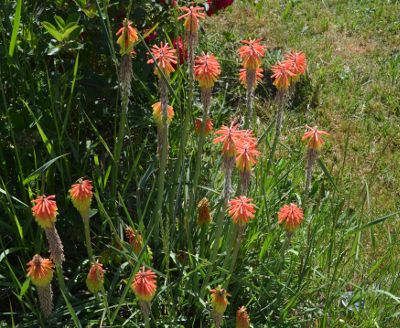 Red hot poker aka torch lily
Red hot poker aka torch lilyWhen I first saw a red hot poker otherwise known as torch lily, it made me think of fireworks.
Hop on Wikipedia and search for flowers in the genus Kniphofia and you’ll see about 75 different species listed, each a uniquely fantastic specimen.
Torch lily is a perennial plant that is just plain fun to look at and is likely to catch the eye of the passerby, insect, and hummingbird, making it a great addition to any garden.
Be More Prepared For Your Next Outdoor Adventure!

Don't leave without knowing these six essential survival skills. Our free survival mini guide reveals the strategies of:
- Shelter & fire to prevent the number one cause of death
- Obtaining clean water to avoid life-threatening dehydration
- Common wild survival foods and other critical skills!

Black Locust (Robinia pseudoacacia)
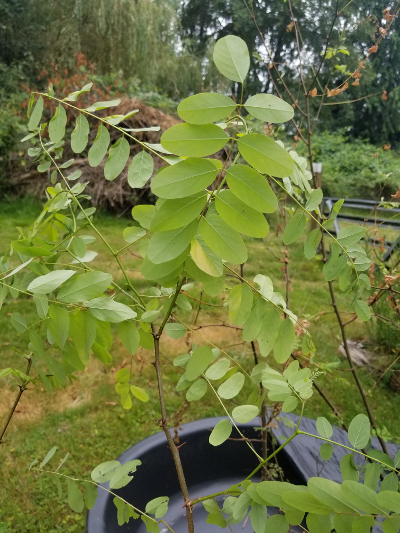 Black locust sapling
Black locust saplingBlack locusts are leguminous, nitrogen fixing trees and can provide those who grow and manage them some great benefits. The black locust in this photo is a sapling and its future use could see it managed in a number of ways.
Once a black locust is established it can be coppiced year after year for dense, rot resistant wood that is great for tool handles and fencing. It is also a great source of firewood. Imagine a coppiced tree that grows out long thick poles perfect for cutting to size for the woodstove. That’s what I’d call a sustainable wood source!
The foliage on a tree that is left to fill out can be used as animal fodder and when mixed with other fodder sources could drastically cut down on your animal feed bill. The flowers are edible and can be made into flower fritters, jelly, and wine.
Highbush Blueberry (Vaccinium corymbosum)
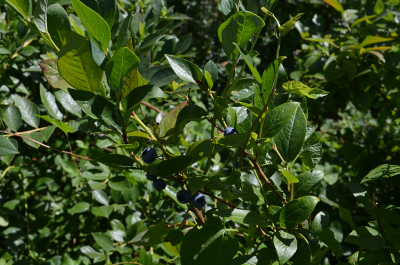 Blueberry bush
Blueberry bushAll of us know about blueberries, right? I’d have to say blueberries are still among my top favorite berries among those I’ve sampled. They are great for making edible hedgerows or just having a delicious berry patch.
Birds love them too, so some sort of deterrent should be employed to avoid sharing your entire harvest. Some people suggest using netting to cover your bushes as the berries are ripening. I’ve observed a scarecrow deter enough birds to have plenty of berries available for when you feel like harvesting.
There are many different species available so check out what permaculture plants people in your area are growing successfully. This is a good tactic for any plant you want to grow.
Jostaberry (Ribes nidigrolaria)
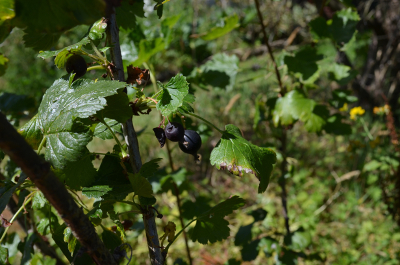 Jostaberry plant
Jostaberry plantJostaberry is black currant and gooseberry hybrid created in the 1970’s. It produces blueberry sized fruits that are tasty and freeze well. It is a thorn-less berry bush, which is something I’m always looking for in a plant I’m planning on harvesting from.
I wanted to put a plug in for the jostaberry simply to advocate for a diversity of permaculture plants in any project you decide to work on. Having a diversity of different species leads to less disease and less pests in most cases.
Lavender (Lavandula spp.)
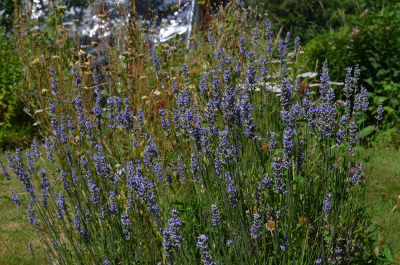 Lavender plants
Lavender plantsLavender is a plant I’m in the process of propagating quite a bit of for all of its great benefits.
For one, it’s just plain pleasant to have around with its nice flowers and strong, calming fragrance. As such, it attracts pollinators and beneficial insects.
Lavender is perennial and once established, it is a very hardy plant able to withstand considerable neglect and heavy pruning.
I harvest lavender in bloom to dry for use in tea, salves, and as an addition to some quirky wine. I also cut lavender just to lie around the house or toss in my car dashboard to really add a pleasant smell to the air.
Red Clover (Trifolium pretense)
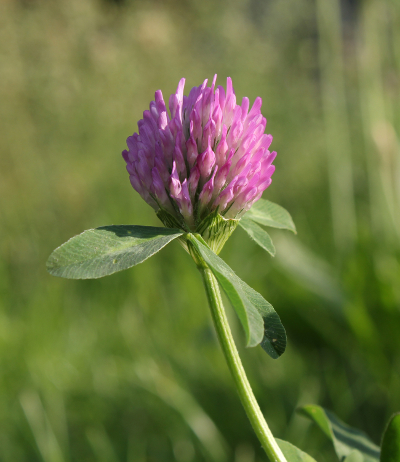 Red clover
Red cloverRed clover is commonly used as a ground cover to hold soil nutrients in planting areas that are lying fallow or overwintering. It is nitrogen fixing and when grown as a ground cover it is normally turned into the soil or chop n’ dropped in spring to support the soil.
I’m planning on casting red clover seed onto an area that was used as a pig enclosure earlier this year. This will be in an effort to revitalize the soil that has been made barren by the long term presence of pigs rooting up every single plant available.
Red clover’s aerial parts are edible and can be made into flower fritters, brewed into a tea, or as an addition to salads.
Basket Willow (Salix viminalis)
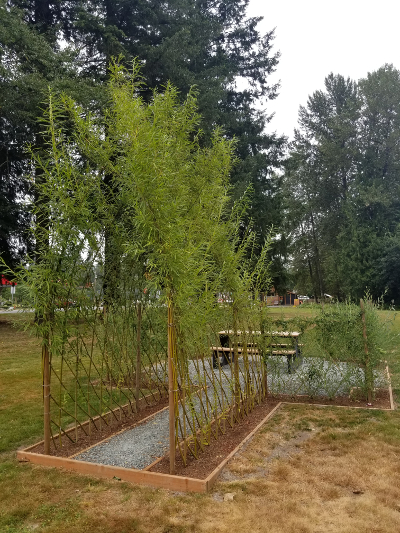 Living willow structure
Living willow structureBasket willow is a plant I’ve been fascinated by for some time now. This willow is known for its pliability and tendency to put out long thin branches that are great for basket weaving or weaving structures.
In the picture, you can see the progression of a woven willow archway to a picnic table after a year of growth.
I’ve seen woven willow entryways, chairs, and even the progression of woven willow bridge over a seasonal marshland. The potential for creativity with willow is huge.
If that isn’t enough for you, willow can be used as animal fodder. The leaves and bark contain the chemical salicin which when ingested is converted into salicylic acid, a natural pain killer and the base upon which asprin was derived.
Snip off a spring shoot or “whip” from a willow and just stick in the ground. Chances are good that a new willow will grow from that whip. Willow contains indolebutyric acid which is a strong rooting hormone. A strong willow tea can be made to help the success rate of plant cuttings you are propagating.
Grapes (Vitis spp.)
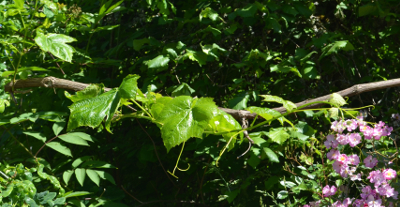 Grape vine
Grape vine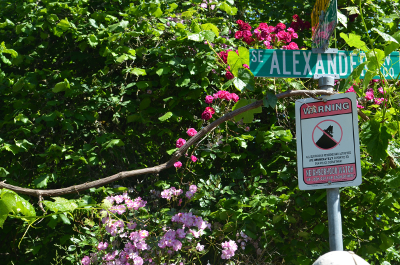 Grape vine climbing over sign
Grape vine climbing over signGrapes are great for filling out trellises, awnings, and sturdy fences. In the photo on the right you can see this particular grape vine is so extensive it’s bursting out of the yard and being trained over the street sign.
Like many permaculture plants, there are numerous varieties of grape to choose from. Do you want to make wine or pick bushels to snack on?
Here’s a pro-tip: If you find yourself making pickles, throw a grape leaf or two in each jar. Don’t ask me how but grape leaves keep the cucumbers crisp. There’s not much worse than a soggy pickle, and that’s reason enough to grow some grapes.
Cardoon (Cynara cardunculus)
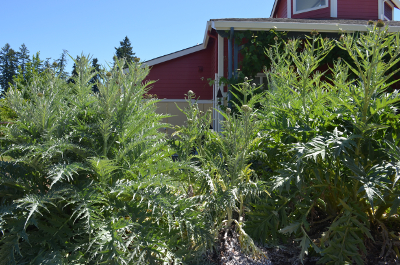 Cardoon plant
Cardoon plantCardoon is a perennial giant thistle and looks a heck of a lot like artichoke. Instead of eating the flower head, as is the case with artichoke, you eat the large, peeled stems which are similar in taste to artichoke but with an aspect of bitterness.
The leaves are huge and can be used for animal fodder and mulching around gardening areas. Like comfrey, it is a great source of biomass.
Jerusalem Artichoke (Helianthus tuberosus)
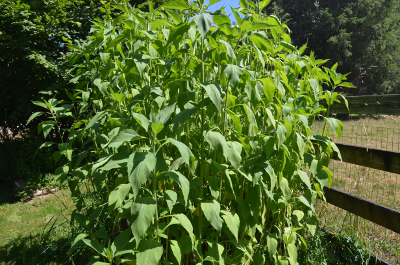 Jerusalem artichoke aka sunchoke
Jerusalem artichoke aka sunchokeSunchokes are perennials in the sunflower family that grow underground potato-like tubers. They taste like a mix between a potato and artichoke. I like to cook them up and mash them just like potatoes.
I’ve spent hours digging up sunchokes to put into produce boxes and you can collect a large amount rather quickly. If you grow a decent size patch of sunchokes there is no way you’ll dig up all of the tubers.
Besides being a great source of food for you, the large aerial parts add a substantial amount of organic matter to the soil when they die back.
I’m interested in utilizing a rotating area to grow sunchokes and then let the pigs root up the tubers for fodder. Nothing beats free food, right?
Celtuce (Lactuca sativa)
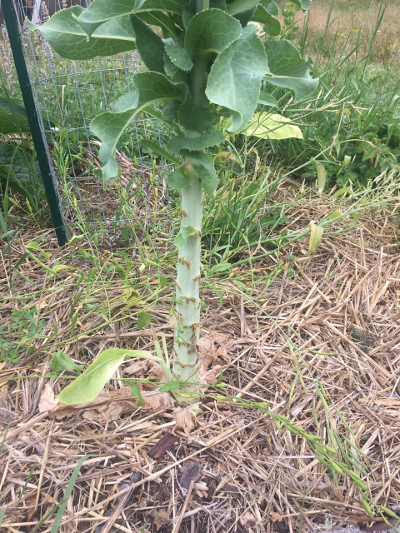 Celtuce aka asparagus lettuce
Celtuce aka asparagus lettuceI just recently discovered the existence of celtuce during a visit to a friend’s homestead on the Olympic Peninsula and was excited to get some seed to take home with me.
Celtuce leaves can be cut during the plants growth and eaten just like lettuce. Once you’re satisfied with the plant's size, you can strip the stalk of leaves and cut it at the base. The stalk is very edible and once peeled can be cooked up or eaten raw. It tastes like a mix between asparagus and bitter cucumber.
I think celtuce is an amazing annual. It makes me wonder what other awesome annual permaculture plants there are out there…
Conclusion
Diving into the world of permaculture plants and which are the best to use in your designs is to embark on a life-long journey of discovery. The designs you make are only limited by your creativity and innovation, whether it is the potted plant in your windowsill or your 100-acre fruit tree orchard.
Push the boundaries of permaculture plants, experiment, and never think you’ve learned enough; there is always more out there!
By the way, a big part of why we love homesteading & permaculture skills so much is because they are a natural extension of learning about wilderness survival (both fields are all about self-sufficiency and working with nature to satisfy needs). An understanding of survival not only helps you become a better permaculturist, it empowers you with life-saving outdoor skills to keep you safe when out in nature. Right now you can get a free copy of our mini survival guide here, where you'll discover six key strategies for outdoor emergencies, plus often-overlooked survival tips.
Permaculture Plants References:
https://www.attainable-sustainable.net/rooting-hormone/
https://teavaskincare.com/salicylic-acid-vs-willow-bark-extract-true-acne-fighter/
https://extension.psu.edu/management-of-red-clover-as-a-cover-crop
https://en.wikipedia.org/wiki/Jostaberry
http://tcpermaculture.com/site/2013/11/18/permaculture-plants-black-locust/
Additional Resources:
Learn about permaculture plants and more at our Permaculture Courses
Research more permaculture plants on the PFAF website

About the Author: Ben Mardis is an experienced educator that is passionate about permaculture and naturalist skills. He is a guest instructor at Alderleaf. Learn more about Ben Mardis.
Return from Permaculture Plants back to Permaculture Articles
Is The Essential Wilderness Survival Skills Course Right for You? Take the "Online Survival Training Readiness" Quiz
See for yourself if this eye-opening course is a good fit for you. It takes just a few minutes! Get your Survival Training Readiness Score Now!

Grow Your Outdoor Skills! Get monthly updates on new wilderness skills, upcoming courses, and special opportunities. Join the free Alderleaf eNews and as a welcome gift you'll get a copy of our Mini Survival Guide.

 The Six Keys to Survival: Get a free copy of our survival mini-guide and monthly tips!
The Six Keys to Survival: Get a free copy of our survival mini-guide and monthly tips!
Learn more